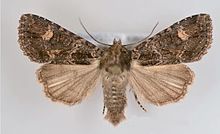| Rusty shoulder knot moth | |
|---|---|

| |
| Male | |

| |
| Female | |
| Scientific classification | |
| Domain: | Eukaryota |
| Kingdom: | Animalia |
| Phylum: | Arthropoda |
| Class: | Insecta |
| Order: | Lepidoptera |
| Superfamily: | Noctuoidea |
| Family: | Noctuidae |
| Genus: | Aseptis |
| Species: | A. binotata |
| Binomial name | |
| Aseptis binotata (Walker, 1865) | |
| Synonyms | |
| |
Aseptis binotata, the rusty shoulder knot moth, is a moth of the family Noctuidae. The species was first described by Francis Walker in 1865. It is found widespread in western North America, west of south-central Alberta, Wyoming, and Nebraska. Along the Pacific Coast it occurs from northern Mexico to south-central British Columbia. It can be found from sea level to altitudes over 2000 meters in a variety of habitats from dense forest to shrub desert.
The wingspan is 29.5–35 mm. It is the most variable species in the genus Aseptis with respect to forewing color and pattern strength. It may be brownish, warm dark brown, pale to medium gray brown, yellowish light brown, or reddish brown depending on locality. The most noticeable marking in dark specimens is the large pale yellowish postreniform patch, which is bisected by the dark postmedial line. The antemedial line is strongly convex laterally and is filled with light tan. Black forewing markings include a series of wedges near the outer margin below the apex, the outlines of the three forewing spots, and in most specimens a short black basal dash. Pale specimens can be washed out or have contrasting dark markings. In the south the flight begins in March at low elevations and in April to July in the mountains. In the north the flight begins later and lasts into August.
The larvae feed on various broadleaf trees and shrubs, including big-leaf maple, ocean spray, and Ceanothus species. Other recorded food plants include Oemleria, Symphoricarpos and Ribes species. The larva is green with a white and red lateral stripe.
References
- Mustelin, Tomas & Crabo, Lars G. (2015). "Revision of the genus Aseptis McDunnough (Lepidoptera, Noctuidae, Noctuinae, Xylenini) with a description of two new genera, Paraseptis and Viridiseptis". ZooKeys (527): 57–102. Bibcode:2015ZooK..527...57M. doi:10.3897/zookeys.527.9575. PMC 4668888. PMID 26692788.
 This article incorporates text available under the CC BY 4.0 license.
This article incorporates text available under the CC BY 4.0 license.
External links
- Caterpillars of Pacific Northwest Forests and Woodlands
- Kistler, Ethan (December 3, 2019). "Species Aseptis binotata - Rusty Shoulder Knot Moth - Hodges#9532". BugGuide. Retrieved October 23, 2020.
- "932634.00 – 9532 – Aseptis binotata – (Walker, 1865)". North American Moth Photographers Group. Mississippi State University. Retrieved October 23, 2020.
| Taxon identifiers | |
|---|---|
| Aseptis binotata | |
This Noctuinae-related article is a stub. You can help Misplaced Pages by expanding it. |